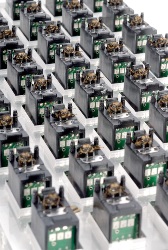Inscentinel, a UK-based biotechnology company, has developed a handheld sensor integrated with live bees to detect dangerous substances in the air. The VASOR136 (volatile analysis by specific olfactory recognition) portable device is designed to hold 36 bees in six cassettes within the device.
 Trained bees held within the device
Trained bees held within the device
Bees have a keen sense of smell and researchers at Inscentinel have trained the honeybees to detect odours associated with a variety of explosive mixtures and compounds, such as Semtex, PE4, DMNB, gunpowder, C4, TNT and hydrogen peroxide. When the bees detect a particular odour, they produce a proboscis extension reflex response (PER) and stick out their tongues expecting food. Bees have the capacity to detect trace vapours in parts per trillion levels. They are easily available and can be trained within a short time period.
The bee holders in the VASOR136 contain microcontrollers, photo sensors and heat resistors. They are clipped into six-bee cassettes and the bee holders are made to face an infrared light-emitting diode. A PER event interrupts the infrared beam and the readings are communicated to the VASOR devices’ display.
Inscentinel researchers have also demonstrated that honeybees could be trained to diagnose diseases such as tuberculosis.